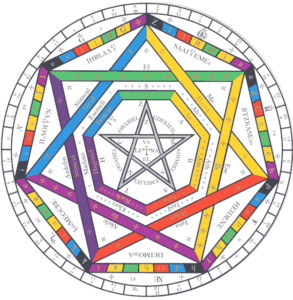 Constructing Enochian Temples
Constructing Enochian Temples
During the six months beginning November, 1985, I was involved in an extended exploration of the Enochian Tablet of Earth. There was no purpose to the work other than tourism – I merely wanted to see what was there and record it as accurately as possible. Curiosity is sometimes well rewarded; instructions were given on a new way to use the Tablets for magickal workings. The method involves the transformation of the two-dimensional Tablets into a three- dimensional structure that is the Temple of the Tablet. The Temple demonstrates the fundamental geometric, energetic, and spiritual properties of the Enochian magickal system through a form embodying the character of its active, intelligent energies.
There is much more to the Enochian magick than a mere collection of elemental energies. Rather, each tablet is an expression of the whole of existence, parallel to the cabalistic Tree of Life and equal to it in power and descriptive ability. With the practical and symbolic tools provided here, the competent magician will be able to unlock the higher aspects of the magick for himself.
Before using the Temple technique, the magician should be thoroughly conversant with the basic attributions of the Hebrew letters and numbers as described in the Golden Dawn documents and Crowley’s 777 Revised. Equally useful is a familiarity with the “restored” Tree of Life first presented by Charles Stansfield Jones, aka Frater Achad. A sketch of his Tree is provided in figure # at the end of this book. Achad’s Tree forms the basis for all existing explanations of the Temple’s symbolism. The author believes that the Temple can be used effectively by persons using other symbol-systems, but at this point it is up to the users of other systems to discover how they can be connected with the Temple.
The magician should have had some success in using the Enochian system to invoke the forces of single squares, and have made a preliminary exploration of the forces of the Tablet in question to the point that he feels both familiar and comfortable with them. This is not a technique for beginners. Successful construction of the Temple generates a tremendous concentration of force, which can unbalance the inexperienced magician and open him to levels he is not yet ready to deal with.
Background
Each of the Elemental Tablets of the Enochian system is a 12 by 13 square board. Figure 1 shows the general layout of a Tablet, with the various types of squares labeled. These squares can be re-arranged into a three-dimensional structure, which is the Temple of the element.
The squares of the Tablets are arranged according to a regular hierarchical scheme, and each level of the hierarchy defines a particular part of the Temple.
The Great Central Cross of each Tablet is made up of the seventh row across the Tablet, and the sixth and seventh columns. The cross contains the highest three levels of the Tablet’s hierarchy.
The three Names of God come from the horizontal line, and are formed by taking the letters in groups of three, four, and five letters. The Names for the Earth Tablet are thus MOR DIAL HCTGA.
The Elemental King of the Tablet has his name formed by an inward clockwise spiral around the center of the Tablet. In the Earth Tablet, the King’s name is ICZHIHAL. (Fig. 2)
The Six Seniors represent the forces of the planets in the Tablet, and their names are formed by reading outwards along the arms of the cross. For the Earth Tablet, these names are ACZINOR, LZINOPO, ALHCTGA, LIIANSA, AHMLICV, and LAIDROM. (Fig. )
These names from the Central Cross are used to make up various parts of the upper Temple. The next set of squares are the Sephirotic Crosses, which are the five by six crosses centered in each Lesser Angle of the Tablet. These crosses make up the floor of the upper Temple, and the ceiling of the lower Temple, and project their force downwards into the Temple proper. (Fig.)
The four Kerubic squares of each lesser angle are the four squares above the horizontal arms of the sephirotic crosses. These squares are used to make the four outer pillars of the Temple.
Finally, the remaining squares below the arms of the Sephirotic crosses are the servient squares, which represent the most material manifestation of the force of the tablet. These squares are rearranged to make the floor and altars of the Temple.
The Bricks
The basic unit in the Elemental Tablets is the square. Since the Temple is a transformation of the Tablets into three dimensions, it follows that the basic unit for the construction of the Temple will be the cube. One particular kind of cube has proven to significantly enhance the effectiveness of astrally-constructed Temples. However, after a short explanation I will continue to refer to “squares” rather than to cubes, in order to emphasize that these cubes are three- dimensional projections of the squares of the Tablets.
These special cubes are formed from four truncated pyramids of the kind used in the Golden Dawn system to symbolize the energies of the Tablets. The pyramids have square bases. Each side adjacent to the base meets it at an angle of forty- five degrees, and the top has sides whose length is one-third that of a base side. The pyramids are then set with their bases outwards to form four sides of a cube, with the top and bottom faces empty.
The cube thus formed acts as an accumulator and focusing device for whatever energies are assigned to it. The four “solid” sides channel energies into the center of the cube. Beams meet in opposing pairs and are thrown outwards in the only directions remaining, as rays from the empty top and bottom faces. The wand-like nature of the projecting forces suggests that this form of the cube be associated with the fire aspect.
Adding a fifth pyramid to the cube neutralizes the opposing forces of the first four, and causes energy to well up out of the sixth side like a fountain, or like a perpetually-opening lotus. Clearly, this form of the cube relates to the water aspect.
A cube of six pyramids perhaps combines earth and air, since all the faces are solid, but the hollow center contains the accumulated energies, distributed at equal concentration at all points of the space.
There are only two places in the Temple where one of these forms is required. Everywhere it is not specified, any of these forms can be used at the preference of the magician, or none of them used. My personal feeling is that the six- pyramid cube is not useful.
It should be noted that all of these cubes are actually three-dimensional representations of a four-dimensional object, the hypercube or tesseract, which is an object having eight cubical “sides”. In the 3-d cube, six of these cubical sides are seen in distorted perspective as truncated pyramids. So the cube, which started as a projection of a two-dimensional form, contains within it the potential for the projection to continue into additional dimensions. By correspondence, the completed Temple will also be linked to other dimensions.
Design
The dimensions of the Temple are all defined in terms of the size of a single component, the square, with the length of the square’s side being the unit of measure. Thus the relative dimensions remain constant no matter how large or small the unit is when measured in real terms. The Temple can be made any size that is convenient to the magician. It can be constructed physically, or entirely on the astral levels. The effect on any plane will be about the same, no matter the materials used. Coloring appropriate to the particular Element should be used.
The intelligences who gave the instructions say that it is also preferable, but not necessary, to paint on the attributions of each square as well. This seems valuable but tedious for a Temple constructed of physical materials. But for astral workings such a course would likely be unfeasible for magicians lacking an eidetic memory.
The floor of the Temple is made by lifting the Servient squares out of the tablet, and pushing them together to make an 8 by 8 board, with the squares maintaining their relative positions from the Tablet. (Fig.? )
The Kerubic squares of each Lesser Angle are arranged in a 2 by 2 square, which touches the corner of the floor. The squares are arranged within the larger square so that they are in the same position relative to each other that their sub- elements are in the Tablet as a whole.
(Fig. )
These grouped Kerubic squares are then extended upwards for a distance equal to eight times the width of a single square to form the pillars of the Temple.
The Sephirotic crosses are connected as in Fig. ?, and are laid horizontally at the height of the tops of the Kerubic pillars to form the inner ceiling of the Temple. The crosses project downwards to form the inner walls of the Temple. The long arms of the crosses are oriented to follow diagonal lines drawn between the Kerubic Pillars, and the Malkuth squares of the vertical arms rest on the top of each pillar. The Malkuth square of each cross is centered precisely over the center of of its quarter’s Kerubic pillar, and the intersection of the four lesser columns that make up each pillar divides it into four equal parts. The
Tiphereth square of each cross will be over the center of the sixteen Servient squares of the Lesser Angle. Also note that in this formation, the squares attributed to Kether and Tiphereth are always hidden from any viewpoint outside of the Temple.
The names of the six Seniors are made into a star-shaped formation. (Fig. ?) The first letter of each name is formed into an equilateral triangle having sides of one unit, and the remaining letters are assigned to squares extending in a line from the base of the triangle. The triangular units are fitted together to form a hexagonal center to the star. Except for this center, the arms of the star-shape are bent downwards at an angle of about thirty degrees to form the roof-braces of the Temple. The outermost square of each arm will be at the height of the tops of the Kerubic pillars. The arms should extend outwards far enough that a circle touching all their ends would just enclose the Malkuth squares of the sephirotic crosses.
The name of the Elemental King is formed into a stack of four fire-aspect cubes, which stands on the center of the Seniors’ star. The outer faces of the cubes in the stack are attributed to the letters of the name in this manner:
E S W N <– (direction of face)
I C I C
Z H Z H ICZHIHAL, Earth Tablet
I H I H
A L A L
The three Names of God in a Tablet are expressed in the Temple as three rings, each having a circumference of 12 units. When it is desired to emphasize the purely elemental aspects of the Temple, the rings are arranged so that they have a common center-point, and the plane of each ring is at right angles to the planes of the other two. When the higher, planetary aspect of the Temple is to be emphasized, then the rings are arranged so that they share a common diameter and their planes are set at angles of 120 degrees to each other.
Example Consecration of the Temple of Earth
(The symbols and visualizations follow the text of the ritual.)
1. The Temple should be fully prepared ahead of time. If an astral or etheric Temple has been built, the magician should be able to hold its image steady without effort for several minutes at least, and to move about inside and outside of it without difficulty.
2. Perform a preliminary banishing of the work area, using both the Ritual of the Pentagram and the Ritual of the Hexagram.
3. Vibrate the First Key, and call upon the Archangel of the Element in the Tablet of Union to oversee the work of consecration.
“Hear me, Ye spirits of the Tablet of Union! Hear me, and send your great Archangel, NANTA, unto me. NANTA, thou great and powerful angel of the Spirits of Earth, I call upon thee to oversee this work of consecration, so that the Light of Spirit may ever dwell in the Temple. I have dedicated this Temple to the work of returning the Earth, the daughter who is our mother, to the realms of the Gods from whence she came. This is my true will, and a great and holy work. Therefore, NANTA, do I call upon you by right to aid in its completion. Let the light of the Gods raise her again upon high. Amen.”
4. Perform a preliminary invocation of the element of the Tablet. (See Crowley’s Liber LXXXIX vel Chanokh for examples.)
5. Vibrate the Key of the Element.
“Hear me, spirits of the Tablet of Earth! Hear me, and come unto me, and make this Temple the true house of the Daughter. I charge you all to make your force known within the Temple, as I call upon you by name.”
6. “MOR DIAL HCTGA, holy spirit, seed of the Unknown God! You are the magnet of the Temple, drawing unto it from the Ethyrs the forces of Earth. Indwell the crown of this Temple, MOR DIAL HCTGA, so that the forces of Earth shall ever flow into it.”
7. “ICZHIHAL, thou great and terrible King who dwells in the center of the Tablet of Earth! Thou who does express the force of the male within the Tablet! Thou Sun, who does blind all with your light! Hear me, and come unto me, and send thy force to dwell in this Temple, ICZHIHAL, so that the light of the Father may ever be seen in the Daughter.”
8. “Hear me, ye Seniors! Ye, who are as Moons to the Sun of the King, who are as Water to His Fire! Ye who represent the god-stars within the Tablet! Ye who do receive and distribute the seed of the King unto the lower worlds! Hear me and come unto me! Hear me:
“ACZINOR, child of Jove, royal and benevolent!
“LIIANSA, child of Saturn, dark and rigid!
“AHMLICV, child of Hermes, bright and quick!
“LZINOPO, child of Luna, reflective and changing!
“LAIDROM, child of Mars, forceful and will-full!
“ALHCTGA, child of Venus, loving and sensual!
“Come unto this Temple, and be its roof, so that the acts of men within the Earth be as the acts of the Gods within the womb of Nuit! Yea, ye children of the Gods, come unto this Temple, and enliven the earth with your flavorful waters!”
“Thus is the home of the Gods within the Temple built. And let Man as well have his place therein. Let the sephiroth enclose him, and the Kerubs guard and focus him, and the Earth herself support him.”
9. “Hear me, ye angels of the Sephiroth within the Tablet of Earth! Hear me, ye who are the walls of the inner Temple, and do hide the light of the Sun therein from the eyes of the profane! Ye, who distribute the elements within the fields of the Earth’s domain! Come unto me, and enliven this Temple, so that Man may see the roads to the Gods, and travel those roads in sureness and understanding!
“OPMNIR, bring thy fiery seed to enliven the Temple. ILPIZ, plant thee this seed in this Temple of Earth.
“ANAEEM, I call thee to pour out the waters of earth, to purify the Temple and make it holy. SONDN, do thee bind these waters to the fabric of the Temple.
“ANGPOI, Let thy wings blow the Airs of Earth into this Temple, so that knowledge and understanding shall be therein for Man. UNNAX, bind thee these winds to the Temple.
“ABALPT, daughter of the Daughter, bring forth thy powers of richness and abundance, so the Temple shall never lack that which it needs for continual comfort. ARBIZ, bind thee this abundance to the Temple.
“Thus are the inner walls of the Temple established, so that the light of the Sun may be concealed, and yet seen clearly by the eyes of Man.”
10. “Hear me, ye Kerubs of the Tablet of Earth! Mighty warriors are ye, set to stand at the corners of the Temple as guards of the mysteries therein. Ye, co- equal with the Sephirotic Angels, whose power does run from the depths to the heights, expressing the same nature in all the worlds. Ye, pillars of the Temple, foursquare and righteous!
“ASMT, thou Lion! By thy Spirit NASMT do I call thee to appear!”
“PHRA, Eagle of the Waters! Obey me by thy Spirit NPHRA!”
“BOZA, Thou wind of understanding! Blow thee here, by thy Spirit NBOZA!”
“OCNC, Thou Bride, Earth most pure! Thy Spirit NOCNC graces thee!”
“Come ye, ye Angels, and bind your forces into the pillars of the Temple, so that they will be a defense and a focus for the light!”
11. “The Temple is built, and Man dwells therein as the child of the Gods. Let the child come to meet his parents, in this place of light. And let the light of the Temple shine forth for all men to see and to wonder at. And let it infect them as does a puissant poison, and shatter their shells to show the Stars therein!
“And let these Stars light the Daughter on her way, as she rises again into the company of the Gods.”
12. Let the magician commune with the Gods within the Temple. Then let him go forth to do his Will.
The Symbolism and Visualizations of the Consecration Ritual
0. Most of this ritual was given directly to the scribe by the “Angels” associated with the Tablet. In transcribing it, the author had the strong impression that the intelligences he was speaking with were consulting a manuscript written in enochian, translating that into some sort of thought-form, and leaving it to him to translate it into English. Thus any lack of artistry in the presentation is probably the fault of the author, and not the communicating beings. Despite this, I feel that the archaism and formal stylism reflects the original.
The ritual is meant only as an example, and the magician is free to vary it or write an entirely new one more suited to his or her own methods. The only essential parts are the names invoked, and the ideas or visualizations associated with each name. The other words and acts are unimportant, according to the communicating entities, and serve only to fire the imagination of the magician.
As an example of a variation, the names on the levels below the Six Seniors could be grouped according to their sub-element, and the sub-elemental keys recited before they are invoked. There will of course be variations in the symbolism if the magician chooses to work with a Tablet other than that of Earth.
The higher intelligences associated with the Earth Tablet have a distinct character of expression that is unmistakable once it is recognized. It has a strongly Masonic flavor, as if every communication or contact was part of a meeting of an Illuminated Lodge. Thus it should be unsurprising that they have concerned themselves here with the building of the Temple. The explanation of the symbolism of the Temple that follows was also dictated, and for the larger part is rendered here exactly as given.
The true Temple is of course Man, and the parts of the Temple are the parts of the spiritual man.
The floor is the unilluminated man, trampled under the feet of those with power, moving blindly at the pull of forces outside himself. With him we do not concern ourselves, for he is upon the earth and we are as heaven, and he does not see us. Thus the floor of the Temple does not need to be consecrated in the building of the Temple, although to do so would increase the power somewhat.1
The Kerubic Pillars and the Sephirotic inner walls are the powers of the soul, and the powers of the Ruach. The soul envelopes the man of earth, and protects him from the powers beyond himself. When, by an act of will, he tears down the veil between the personality and the soul and stops acting as the pawn of mundane forces, then he becomes the pillars and the sephiroth. He uses their strength and fixity to push himself up out of the earth, as Kephra forces himself above the waters in the form of a winged sun. He becomes the manifest expression of a cosmic force, though he does not perceive that force in himself. For though he uses those forces, and wields them to his own benefit, yet are the greater parts of their power above his perception as yet.
The crossing of the forces between the pillars, in the center of the Temple, causes his consciousness to become focused, fixed in place, like the sun at the center of the Solar system. It seems as if the world now revolves around him, like the planets about the sun, and that he controls all within this domain. Yet he is still only a little above the floor of the Temple.2
Once the man has spent some time reveling in his new-found freedom from the forces of manifest existence, he suddenly discovers that even on this new level, he is at the mercy of the Gods. He is pulled this way and that as they travel their paths around the sky, and he travels his with the earth. Each tug of the planets disturbs his spiritual equilibrium, and takes from him a little of that balance and joy that the first experience of the Soul gives.3
Yet again, he must put on his armor and prepare for battle. But this time it is against an enemy far superior to himself. The Earth, he has seen, was but a child’s playroom, and the difficulties to be overcome there simply the play of children. Now he must fight as a man, against those who are his superiors both in strength and in spirit, and he must stand against them in direct combat, showing himself equal to them. 4
But he lacks the leverage to fight them directly, and so, to give himself some chance, he binds himself to the pillars of the Temple, which are the fixed cross of the zodiac, as the mutable cross was the mundane world, the floor of the Temple, and the cardinal cross is the realm of the gods. 5
Upon this cross does he bind himself, holding himself with the nails that he finds there, and gives himself over to the pulls of the planets as they dance their dance of death around him. They attempt to pull him from his perch on the cross, and to throw him down again into matter, there to perish with the dogs of earth. 6
Or so it seems to the mage as he stands upon the cross. There are none to aid him in his struggle, so he must bear the force of the gods fully upon himself. He is Odysseus confronted with the Siren’s song, and Mithra entering the cave, and Jesus on his cross.7 Yet the first of these is the best, for this path of the Temple is a path for knights, and adventurers, and those who dare to go beyond the confines of their own worlds.
He does not bind himself to the cross in sacrifice to some pagan god. Nor does he do so with thought of saving others, for he knows others are not worth saving unless they save themselves. He climbs the cross out of defiance, because it is the only way he can fight against the gods, and come to freedom from their dominance, and stand as their equal in the heavens. 8
For the gods do not make their worshipers like unto themselves, but only absorb them back into themselves. And when the god’s attention is distracted from the lower worlds, then do those thoughts in his mind that were his worshipers vanish, leaving nothing behind.9
Those who fight the gods, and die, and live to fight again are those who the gods welcome as brothers, for within the greater world are none accepted save those who are able to stand on their own, free of the support of the gods, and who make their own paths through the endless wonders of Nuit.10
So the gods attempt to tear the man from his place. But the nails of thecross hold him fixed, and he does not fall, despite the greater will of the gods. For the pillars of the Temple are strong warriors, in the earth and in the heavens, and none may remove them from their posts.
Eventually, the pulls of the gods do lessen in force, and the man finds them fading from his mind. All save the gods of the outer darkness, beyond the ring- pass-not of Saturn. Those do call equally to all, and do affect the gods as they do affect men, calling to them to dissolve themselves in the night, speaking to them of the greater universe beyond the solar system. But the man himself finds the other gods do not call to him as they used to, and he takes himself from his cross, and climbs down, and looks about him.11
At first all things seem unchanged, from when he was upon the cross. Yet he has gained great knowledge, in his fight with the Gods, and he does look about the Temple, and he sees that his pieces of knowledge do greatly resemble those upon the inner walls of the Temple. Carefully does he fit each piece to its place, checking each against its pattern in the walls. And when he fits the last piece into place, and does call out to the gods of men to observe his creation, then do the inner walls open for him, and lead him into the sanctuary of the Temple. For his life and being is itself the key to the Temple, and all therein must be applied to its place in the wall to unlock the door of the sanctum. 12
Having put each piece of himself into the keyholes of the inner door, he has stripped himself of himself. Naked and bereft of protection does he enter the Sanctum, and as the doors close behind him, a brilliant beam stabs down, and blinds him, and burns all that he was from himself.
And in the place of the man in the Temple there now stands a Sun, brilliant as the light which kindled it, shining with a glory that can not be denied, and giving to all of its light, unreservedly. 13
But the man who was there is beyond this sun. For the Gods have come unto him again, this time as brothers and sisters, and they do raise him up among themselves, and do greet him as a younger brother, now come for the first time into the affairs of adults. And the gods do give to him of their nectar, that sweetness of the throat and of the spirit, that water from the womb of Nuit that the gods do feed upon. And the sweetness of the nectar in whatever flavor he may drink does transform that man into a god himself, making him in truth as one of the brothers of the Sun. 14
The gods also show him that their pulls at him upon the cross were not of malevolent intent. Rather, were they midwifes at his birth into the heavens, and their pulls upon him were their efforts to pull him from the womb of his mother. As the child is frightened of the process of birth, yet comes through it unharmed into a larger world, so is the crossing of the adept into the heavens. There is no Abyss, save in the minds of lying Piscean magi. There is no separation between god and man. One is simply the unborn form of the other, as the ritual does show. There is no destruction of the self in the formation of the god, but only an expansion, a greater life absorbing that which was once thought to be all of the self.15
Our mother/daughter the Earth is the womb of Nuit incarnate. The passage between the womb and the god-lands is the dark night of the soul, when all seems lost, and nothing of any meaning. Yet this is not an abyss, but only an interval of uncertainty and upheaval between the certainties of the womb, and those of the greater day, which are the man’s true life.16
Now the gods have made that man as themselves, yet still within the Temple does the Sun shine. And that sun remains within the Temple as a light for all to see, burning through the veils of the inner Temple, shining between the pillars of the guardians. For all to see, we say, be they initiated or not. Yet the blind can not be made to see, no matter how bright the light. And those who still dwell wholly within the worlds of the elements will not see that light. It shall be as a great darkness to them. Yet within them shall it still work, burning from then the sins of their youthful times upon the earth.17
And the light grows ever stronger, as that new god does rise in the sky, and shed his light in the heavens. And the god’s light supplies the sun of the Temple with its power, increasingly so as the god rises fully into the heavens.
Now do the new gods fellows reveal to him the mystery of the star-roads, those roads that exit the system into the greater night of Nuit. They show him that these roads are endless, and that all are gods alike traveling those roads, moving from wonder to wonder within the heavens, praising the infinite marvels of Nuit. From wonder to wonder do they travel, and each along the way discovers new ways and things, and does tell his fellows of them, and each does look to the wonders of all. And all of them, every one, is unique within the heavens, both in his self and in his path. 18
Think ye not that since this road has no end, that it has no beginning. For the beginning of the road is here in the earth, and in those other worlds of similar type that do come within the star-fields as the cradles of gods. And all those who come out of the earth will be ever related to her, within the annals of the gods. And each new god’s success does add to the praises that the elder gods heap upon her. For her work is the most difficult that any god can aspire to, and none may gainsay her place when again she rises among them.19
And you, o man, who does write these words at the bidding of your god, and of the elder gods who are his brothers, do know the truth of what we say. For you are yourself the supreme example of this path, which is the path of Set within the Cosmos. He has placed you in the world at the start of time and you have followed his path from beginning to end, in the many deaths that you have suffered at the hands of your fellows, and in the many conquests you have made. In your battles with your brother, who is Horus, you have shown the struggles of man, the struggles of light to free itself from the darkness and to return to the greater world of the gods. And now Horus, the undefeated, has fallen of his own ineptness, and has lost his chance to rule. And the dark brother, who is yourself, he who Horus does sacrifice upon his altar so that his own light might appear greater in the eyes of man, has come to his own reward. For he has shown himself to be the equal of Horus, and unconquered though many times has he been killed.
And Horus, in his knowing of the ways, did strike to the heart one last time, seeking to destroy you in your moment of Triumph. And he did succeed, he thought, until his body did die, and he did again see clear with his God’s eyes, and know that his own desperation to succeed was the cause of his failure to do so.
Now does Set rule in his own name, and not in the name of the Beast Who Was. For that lion, that self-proclaimed beast, did forfeit his right to praise with his last act of treachery, and therefore is he judged a failure in the eyes of the Gods.
Now does Set, the light in the darkness, the serpent in the depths of the Earth, show himself in the minds of Man. Through many do I speak, for my message is for all. Yet there is one who is my special priest, and my own beast, who I do set in place in the East at this equinox of the Gods, when the jeweled stars of Hadit do stand above against the backdrop of Nuit, and I myself do penetrate the mysteries of the Earth in my place at the western horizon. Thus are the Gods revealed, in this new aeon.20
(The scribe again speaks with his own voice from this point on.)
2. It is necessary to banish using both the Pentagram and Hexagram rituals, because the forces invoked operate on both the elemental and the planetary levels. Also, the rituals serve as a preliminary “tuning in” to the higher planes, making the later work more effective.
3. The conception here is of a brilliant, sourceless light, containing all colors and filling unlimited space, permeating everything within that space unhampered. This light should be seen as the manifest expression of the creative god of the Enochian magickal system, whose invocation is silence. The magician should try to fill his perception with the energy generated by vibrating the name, and then work from there to identify himself with the one who created that energy.
The First Key’s language is a commemoration of that god’s steps in the creation of the Tablets. In building the Temple the magician seeks to reflect the god’s act of creation. So he must try to identify with the god here at the beginning. The remainder of this ritual is a steady progression from the macrocosmic and the general towards the microcosmic and the specific.
After gathering the materials for his creation, the god anchored them into matter in the form of the Tablets. The Second Key commemorates this one step within the larger act of creation described by the First Key. It generates those “fires of gathering” and the embodiment of the will within the form aspect. However, we do not use the Second Key in consecrating the Temple because it sometimes has the effect of collapsing the Temple back into its two-dimensional form.
The mage should change the dedications here and in point 11 to suit his/her own purposes. Use of the dedication given here would cause the mage’s Temple to resonate with the author’s Temple, and with the author’s assigned task as a Master of the Temple. This could result in distortions of the mage’s intent, when he seeks to use the Temple in his own work. If the mage or adept has no such specific task, a dedication to the accomplishment of the Great Work should be used. However, use of the given dedication is all right if the mage seeks to unite himself with the purpose stated.
The mage declares the righteousness of his work, and charges the spirit to assist in its completion. The enochian spirits see man as part of a spiritual hierarchy parallel to their own, whom they are charged to assist by their creator. But the enochian spirits also assume that if the mage is expressing doubts, or conflicts of will, it is because he wants the spirits to manifest in a form reflecting those things. They are perfectly responsive to the will, once invoked, and therefore must the mage’s will be single, and steady.
4. This is a further “tuning in” to the forces to be used in the consecration.
5. The light generated by the use of the First Key should take on something of the quality of the element as the Key of the Element is invoked.
6. The conception here is of Nuit, infinite space, and the infinite stars thereof. The magician should make every effort to perceive himself as existing within a space of infinite extent, which is formulated by the god out of his magickal light. No matter how far the magician projects in any direction there will be infinite unknown territory beyond.
The rings of the three names are seen suspended in this space, far from any star or planet. As the each of the three names is vibrated, the corresponding ring is filled with a circulating current, which in turn draws even more energy out of space. As if in response to the vibration of the name, a ray of light in the color of the corresponding zodiac sign should be drawn in from infinity to strike the ring.
The zodiacal correspondences of the names are shown in this table:
Mutable Fixed Cardinal
Fire OIP TEAA PDOCE
Water MPH ARSL GAIOL
Air ORO IBAH AOZPI
Earth MOR DIAL HCTGA
Vibrating the name MOR would cause a response in the colors of Virgo, DIAL in the colors of Taurus, and HCTGA in the colors of Capricorn. These incoming energies are accumulated in a dimensionless point in the center of the sphere described by the three rings.The rings continually draw in more energy and pour it into this point. The point is Hadit, the complement of Nuit, from whom the three rays come.
An alternate conception of the Three Names was sometimes used by Dee. It assigns the names of four letters to their respective Kerubic signs, and assigns the names of three and five letters to the adjacent mutable and cardinal signs. This latter set of attributions is more useful in purely elemental workings.
In terms of the overall structure of the ritual, the light of point 3 can be viewed as the Limitless Light, the Ain Soph Aur. The infinite space is the Ain Soph, without limit, and the point at the center of the rings is the Ain, nothing, and its concentration into the dimensionless point of Hadit at the highest level of Kether.
7. As the King’s name is vibrated, the forces activated punch through the sphere formed by the Three Names, and provide a channel of escape for the energies concentrated by those names. These energies should be visualized bursting out of the dimensionless point and down through the center of the King’s column.
The letters of the Elemental King’s name are attributed to the sides of his column in such a way that four spirals can be drawn around the column connecting the letters in the correct order. Two of these spirals twist clockwise, and two counterclockwise. These spirals ensure that the energies are brought down in a balanced form. At any horizontal plane along the length of the spirals, the two spirals in each pair will have vector components that are exactly opposite. As one spiral turns east, the other turns west, and so on.
As the energies pass down through the column, the spiral effects of the King’s name imparts spinning motions to them. Passing out through the bottom of the column, they should be visualized as a beam of sharp, laser-like quality, of such brilliance and intensity as to seem almost solid. This beam projects all the way down to strike the floor of the Temple, and illuminates the entire area of work. The beam can be white, or the King Scale color of the element.
The pinpoint of light is Hadit, Kether, and the shaft is his expression in Heru-Ra- Ha, Shin-Tiphereth-Kether combined. The Elemental King represents the Sun in the Tablets, and here he is conceived as the Central Spiritual Sun and the Sun of the soul combined.
8. Here the conception is of a watery/airy nature, forces flowing outwards and downwards from the central letters to a circle touching the ends of the roof- braces at the level of the tops of the pillars. From there, the waters drop directly down, making the outer veils of the Temple.
The planets “step down” the vibration of the Sun, and show its multiple aspects in a form that can be perceived on the lower levels. So they are saluted here as receivers and distributors. As each name is vibrated, the magician should try to get a sense of the force of the planet being invoked, and perceive the waters to carry a flavor expressive of this force.
An identity is asserted that as the stars are to Nuit, so Man is to the Earth. It is exactly the same relationship expressed on two different levels. The earth is a womb out of which new stars, the mages, are born, to begin their true life in the greater womb that is Nuit.
Last, it is declared that the part of the Temple dedicated to the gods has been completed, and that we now begin to build the part wherein the man dwells. The form of man’s section of the Temple is summarized.
9. The Sephirotic Crosses are seen as projecting their force downwards from their place on the ceiling of the Temple, forming walls around the shaft of light in the center of the Temple. The walls maintain the form of the connected crosses, and appear to be of some shimmering, translucent substance of vegetable origin, such as amber or frankincense. They exude rare scents that fill the area within the outer veils.
The sephiroth hide the light of the central sun, because they express his multiplicity, but not his unity. That is, they do not express the sun as he is in himself, but only his effects upon the world. At the same time, they reveal him, because they are an orderly and consistent expression of his will, and so they are spoken of as showing the road to the gods.
There is a sharp division in the Tablets between the macrocosmic aspects, whose symbolism is based on the number six, and the microcosmic aspects, where the symbolism is based on the number four. The link between the two is in this cross of ten squares. The King’s beam of light acts as the fifth element of Spirit for the lower Temple, but neither the Sephirotic crosses nor the Kerubic columns touch that beam. The six highest squares of the crosses receive and “step down” the King’s energy for distribution into the Lesser Angles in a way analogous to that of the Seniors for the Tablet as a whole. The six squares attributed to the planets in turn channel the energy to the the lower four squares, which have elemental attributions. The crosses mediate the two systems, interpreting each to the other and binding them together.
The forces of the sub-elements are then invoked, and bound into the fabric of the Temple. The mage should feel the forces of each element as it is called, and direct it into the appropriate cross on the ceiling of the Temple.
10. The conception is of strong, pure, immovable powers, of equal strength at all points along the length of the pillars. The color of the lesser angle should be seen flaming on each pillar as its name is invoked, and the kerub of the sub- element should be seen standing within the column, facing outwards with the correct magickal weapons in hand. The sub-elemental kerubs all have the head of a bull, with the bodies of the kerub ruling their particular sub-element. For example, the kerub of the Fire Lesser Angle is bull-headed, with the body of a lion.
Alternately, they can be visualized as having the bodies of men, and the heads of the kerub of the Tablet’s or the Lesser Angle’s element. The Egyptian guardians of the quarters could also be used, or the telesmatic gods of the G.D. system. The Kerubs radiate their power with a distinctly fearsome yet exquisite purity.
As the last of the pillars is charged, sheets of force should be seen extending between the pillars, interpenetrating with the curtain previously formed by the waters of the planets. Sheets of force also extend diagonally across the Temple, crossing at the beam of light in the center.
(When the mage uses the consecrated Temple at a later date, these sheets of force and also the inner walls formed by the crosses can be allowed to fade from sight once they have been invoked, so as to leave all of the inner space of the Temple free from obstructions. It should also be noted that in the consecrated Temple, the Kerubic pillars will tend to cloak themselves in black, and no effort should be wasted to prevent this effect.)
11. The success of the consecration is declared, and the dedication is repeated in different terms.
12. Since the Temple is intended to be a permanent home for the forces, there is no banishing or dismissal at the end of the ceremony. If banishings are deemed necessary as part of the later use of the consecrated Temple they should be done in such a way that the entire Temple is enclosed within the circle of banishing.
Last Words
[This final “channeling” formed the basis for most of the visualizations of the consecration ritual. It describes the completed Temple.]
The three names of god within the quarter of the element are the signs of the zodiac in their glory, the outward-most manifestation of the God of Justice.
In the light provided by these twelve gods are all things governed within the earth. And in the light of the gods of one element is the Temple of the element built.
The three gods form themselves into interlocking rings, showing in their orientation the three dimensions of manifest space. Within that space is the Temple formed. On the top of the temple do the three rings stand, and they project their force into every corner and crevice within the area of working.
Also do their forces gather at the center of the globe they form, there do they form the whirl which is the first manifestation of the King of the Elemental Tablet. The light from the center of the globe erupts downwards into the temple, a blazing beam of light, a godflame.
Thrown outwards by the force of the blaze are the Seniors. I see their light as a wellspring of nectar, a flowing-forth of the sweetness of the vine, quenching the thirst of the King’s flame. Outwards they flow, then downwards, a curtain of liquid glory enclosing the outskirts of the temple proper.
The curtain is needed to protect the inner temple from the winds of external change. For the inner temple is filled with sweet airs and incense, and the slightest breeze would blow them away.
The airs exude from the gods of the crosses. Gods of the living air are they, trees of Life which man may climb to the heavens. One moment they stand in the roof of the Temple, above all, projecting downwards the light of the gods. Another moment, and they grow from the roots of the Temple, rising upwards. Resinous woods are they, and each gives to the airs its own unique scent. Breathe ye deep of that incense of life, and live. Above all and in all are they.
Mighty warriors are the guardians of the Temple. Standing at the corners, seeing every way for the safety of their Temple, they conceal a terrible fire within their cloak of darkness. In them are the beginnings and ends of things, and the secret of their continuance. They mix the fire and the water, the air and the earth, and out of them form pillars terrible to behold in their fullness. If they should once fully remove their cloaks in the presence of the mage, he will never again be able to say that he has not looked upon the countenance of the vengeful god. At their heads, flames leap upward into the sky. As they move their feet the very earth trembles beneath them. The waters they drink through the palms of their hands, and the airs come forth from their mouths in raging tempests.
Yet in them yet is the light of the higher gods, a nimbus about the heads of the pillars, flowing down their columns, cloaking their fury with the gentleness of spirit. The gods of the airs21 are their mentors and shapers, and move them in the ways of nature.
Now do we move to the outside of the Temple, and place the altars in their places. In the four corners are they, in line with the God-king and the guardian of the quarter. Under their [i.e. the Kerub’s] eye are the altars placed before the eyes of men. Grails are they, full of the waters of the spirit, the transubstantiated substance of Adam Regenerate, seeking to lead all men back to Eden.
As the Sun consumes its own substance to give life to the worlds, so is Adam consumed in his giving to men. Yet he is not lessened thereby, for he receives in turn a wealth of substance greater than all he has given.
A consuming fire is He, yet his sacrament is of water and air to the lesser folk. For were they not reinforced therewith, his worshipers would cease to be in the instant of true communion, a dust scattered by the roar of his flames.22
Drink of the blood of Adam, o men, and be raised to Eden thereby! Its heat shall consume ye, yet ye shall not perish. As the flames of the heart drove ye out of Eden, so shall they lead you back.23
Correspondences
The Tablets and the Tree of Life
Kether the Three Names of God
Chokmah the Elemental King
Binah the Seniors
Chesed Sephirotic Cross name of six
letters
Geburah Sephirotic Cross name of five
letters
Tiphereth Kerubic Archangels
Netzach Kerubic Angels
Hod Servient Archangels
Yesod Servient Angels
Malkuth cacodemons
The Kerubic archangels manifest only that aspect of Tiphereth that relates to the four lower sephiroth. The combined effect of the Sephirotic cross names can be considered as expressing the macrocosmic aspect of Tiphereth.
The Tablets and the Four Worlds
Atziluthic Three Names of God, Elemental
King
Briatic Seniors
Yetziratic
Upper Ruach – Sephirotic Cross, Kerubic
Archangels
Lower Ruach – Kerubic Angels, Servient
Archangels and Angels
Assiatic cacodemons
(The Seniors are also partially Yetziratic in nature, since their “curtain” in the Temple covers all the same levels as the Kerubic Angels, which are definitely of a Yetziratic character. Similarly, the Sephirotic cross angels must have something of Briah in their nature, since they form the floor of the upper Temple, as well as being the roof of the lower Temple. They are attributed here in terms of their dominant natures.
The Temple and Man
- Three Names of God – the top-of-the-head chakra, the halo around the head
- Elemental King – the top-of-head chakra’s anchor in the head, and its extension in the channel of the spinal column
- Seniors – the other six “lights in the head”, and the aura considered as the matrix within which the lower bodies form. The “sphere of sensation”.
- Sephirotic Angels – The “Buddhic” and “Atmic” bodies, the link between spirit and the purely human levels. The “higher mind”.
- Kerubic Archangels & Angels – The other chakras, and the arms and legs, both considered as the instruments by which man acts on the world. The being-in-the-world as opposed to the spiritual being. The mental bodies.
- Servient Archangels – The astral/emotional bodies
- Servient Angels – the etheric and physical bodies
- The macrocosm Three Names Elemental King Seniors
- The link Sephirotic Cross
- The microcosm Kerubic Angels & Archangels Servient Angels & Archangels (Cacodemons)
Additional sections of Enochian Temples
The Lower Temple. — Instructions for constructing altars from the “servient” squares of the tablets, and their basic symbolism. Includes 2 channelings describing their place in the Temple initiatory system.
Analysis of the First Key.
Invoking the Cacodemons. 5 pages. Record of an astral contact describing the use of the Temple to invoke the “cacodemons” of the Enochian system.
Generating the “Abyss” Experience with the Temple. Techniques for invoking the void of the Abyss.
The Aeonic Perspective of the Enochian Temples. The INRI/IRNI formulas, their relation to the Temple initiatory system and the Set/Horus duality. The cosmic effects of the Temples, and suggestions for using the Temples.
Set/Horus. Further examination of the Set/Horus mythos, its astrological characteristics and relation to the INRI formula. The Temple initiatory system in the Grail myths. The manifestation of INRI in other parts of the Earth Tablet Working.
Footnotes
1 This particular presentation is concerned with the way the Temple relates to the paths of the Adepts and Mages, from Tiphereth to Kether. The Temple’s relation to the man of the earth will be covered in another section.
2 All attributions follow Frater Achad’s version of the Tree of Life. These two paragraphs relate to Tiphereth, and to the path of Aries, which connects Tiphereth with Geburah.
3 Oin, The Devil, in his early incarnation as the tormentor of men. The planets are the primary influences operating above Tiphereth as the elements are the main influences below.
4 Geburah.
5 Scorpio. The “binding” is the intense concentration that this sign generates.
6 More Scorpio. In the Temple, the pull of the gods at this stage comes from the outer curtain formed by the power of the seniors. See point 8 below.
7 Pisces. Jesus is obvious. Odysseus is a sailor. Mithras in one form is Jupiter, ruler of Pisces.
8 Path of Mars, connecting Geburah with Binah. The rebellious Son. Also Capricorn as Lucifer, the Angel who set himself up as a god.
9 Path of Sol, connecting Tiphereth with Chokmah. I also got the impression that the idea was related to the Hindu idea of the cyclic universe, which comes and goes from manifestation.
10 Sagittarius, connecting Chesed and Chokmah.
11 Chesed.
12 Chesed and the path of Sagittarius, connecting it with Chokmah.
13 Shin, connecting Tiphereth with Kether. In the Temple, this light is a beam passing down the middle of the Temple.
14 Binah. In the Temple, this stage refers to the second function of the Seniors, acting as the roof of the Temple.
15 More Binah. The effects of the path of Capricorn are also shown to be the reverse of what they were first perceived to be.
16 More Binah.
17 Resh, Shin, Oin, the three paths connecting Tiphereth with the Supernal Triad. This time seen from above Binah.
18 Chokmah.
19 Binah, and The Universe, which connects it with Kether.
20 This interprets the signs of the fixed cross of the zodiac as the angles of a horoscope. Aquarius, the force of the current aeon, is at its height, and therefore at the midheaven. The sign of Taurus is the ascendant, the power just rising into view, the “face” the gods present to the world, and therefore the most effective on the Earth. The god sets himself on the descendant, as the serpent going into the Earth. The Earth is represented by the nadir.
21 That is, the gods of the Sephirotic Cross, just described as airy, and not the Thirty Ethyrs or Aires that are another part of the Enochian system.
22 This paragraph identifies the regenerate Adam with the whole Tree of Life. In Achad’s version of the Tree, the paths of the middle pillar are (from top to bottom) Shin, Mem, and Aleph. The man who is Adam brings the light of Kether down into the worlds through these paths. The two earlier sacraments of Air (aspiration) and Water (devotion) must be fully absorbed before the true sacrament of Fire can be taken. The dust mentioned in the paragraph is of course Malkuth, Earth. In terms of the Enochian Temple, the altars/grails (representing the personality) must be shaped (Air) and consecrated (Water) before being filled with the fiery blood of Adam, represented in each Lesser Angle by the Sephirotic Cross.
23 This paragraph is a mystery of Tiphereth and the four sephiroth closest to it. The paths connecting the sephiroth around Tiphereth form a rectangle, which other paths divide internally into four triangles. In Achad’s Tree, the sum of the paths forming the upper and lower of these triangles is 177. 177 = GN ODN, the garden of Eden. The sum of the triangles to the left and right of Tiphereth is 161, which is the numeration of ADM OILAH, the primordial (lit. “causative”) Adam.
Copyright year, 1992 by Benjamin Rowe
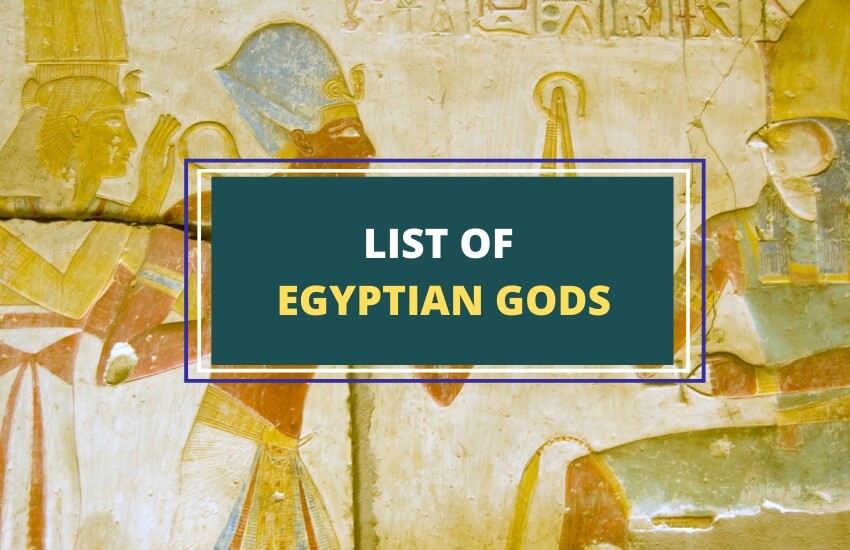
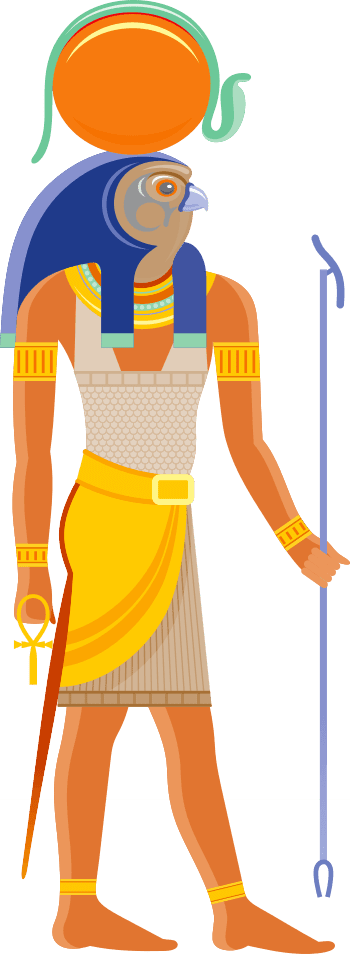
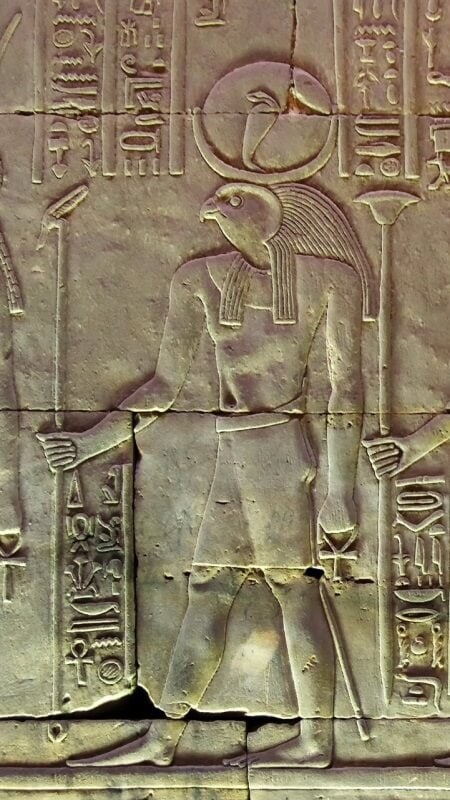
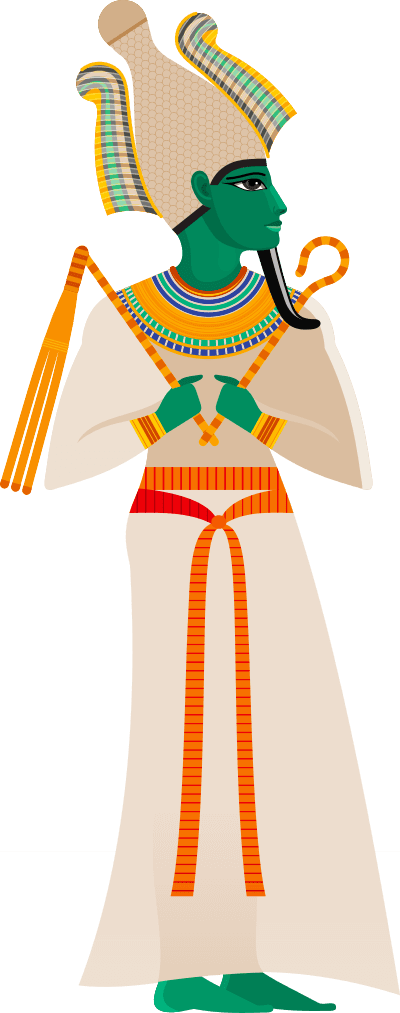
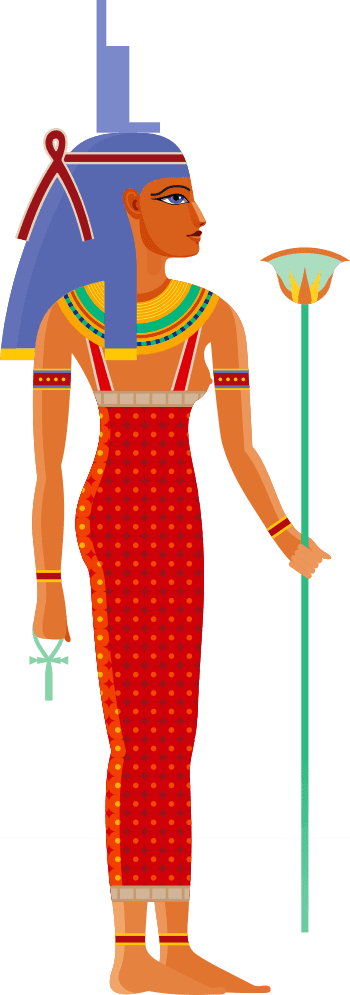
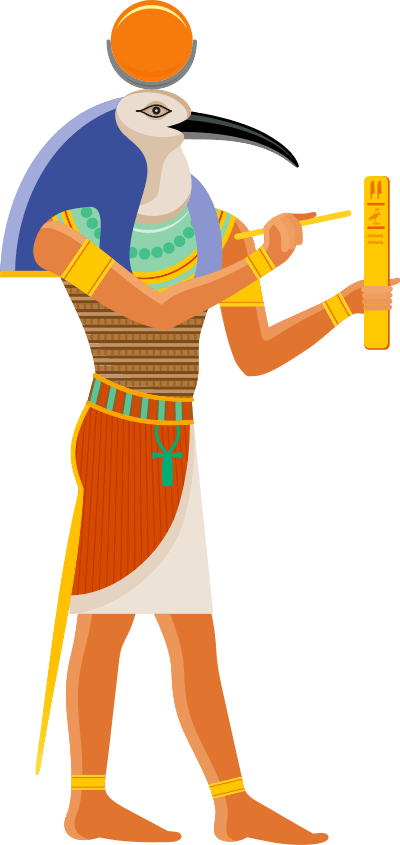

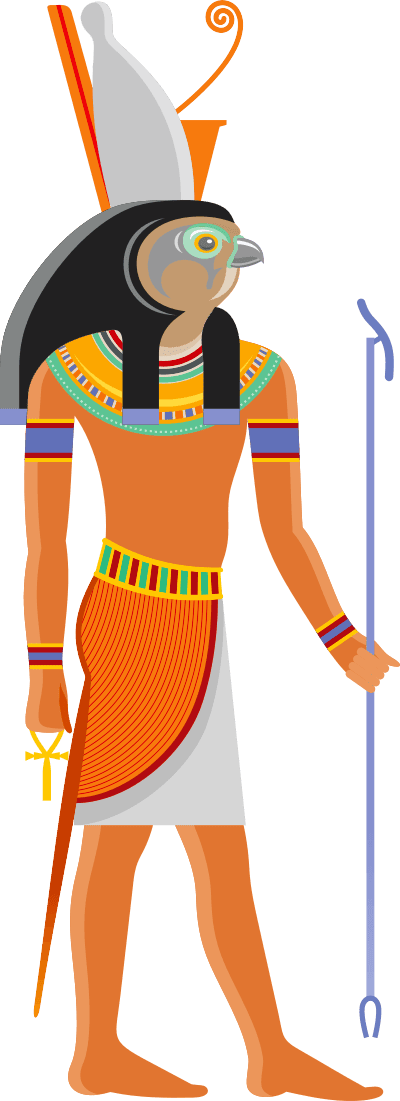
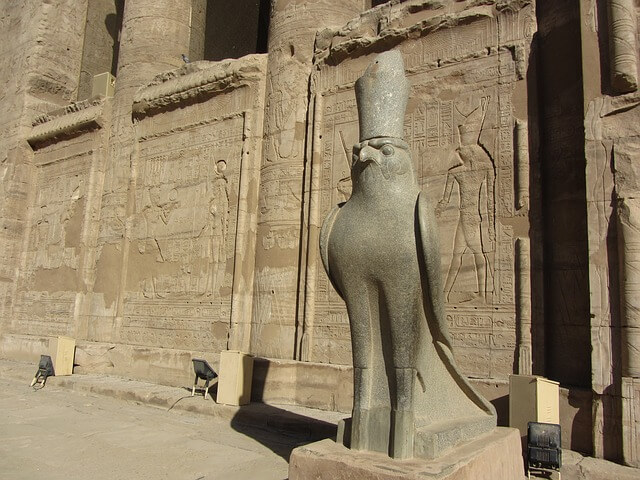
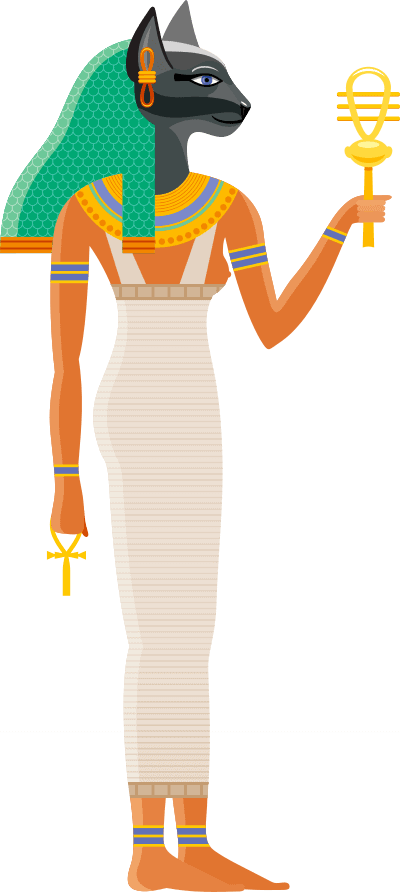
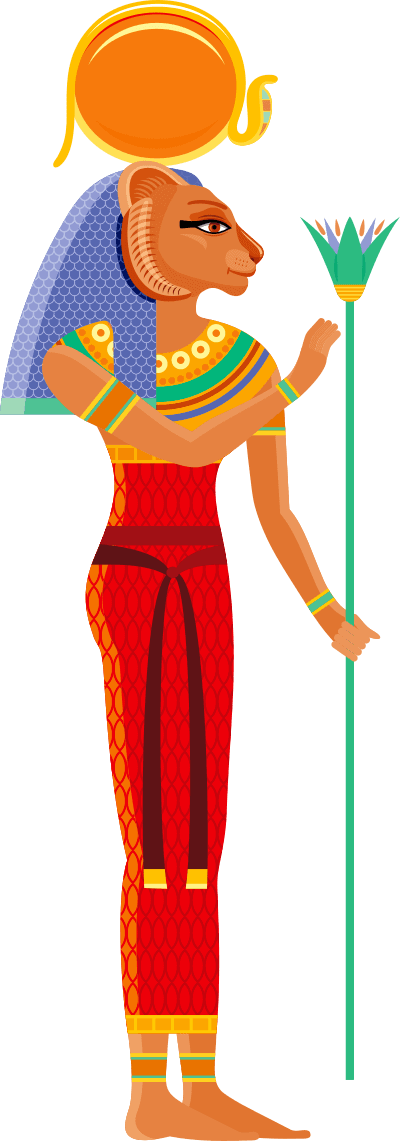

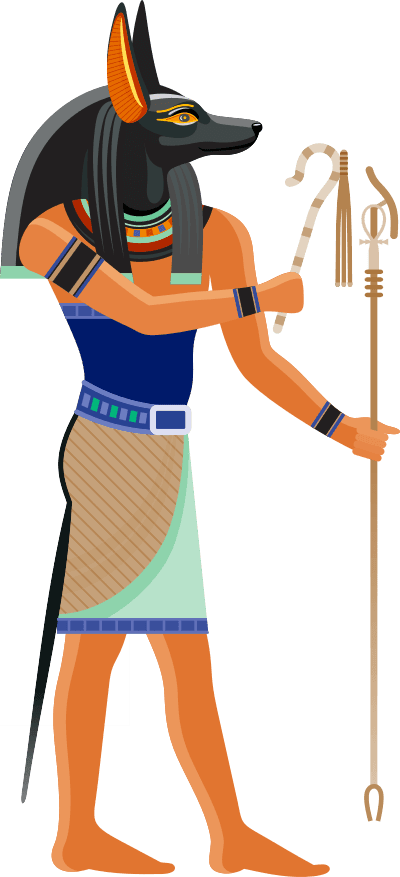
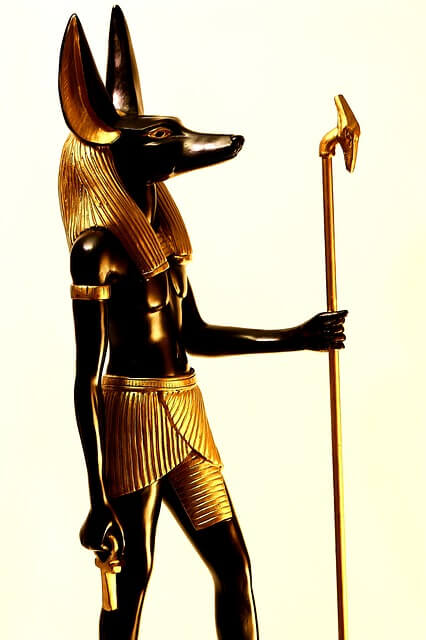


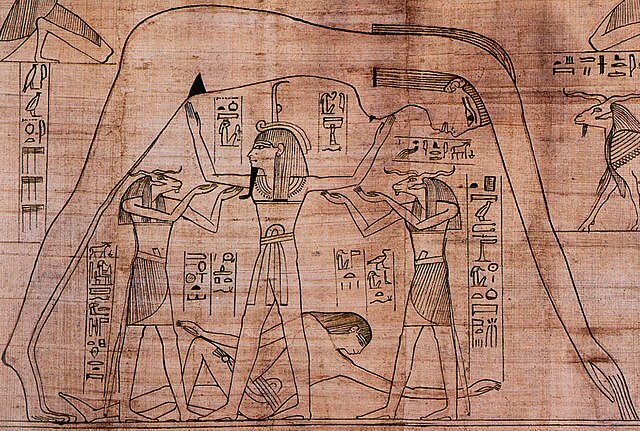
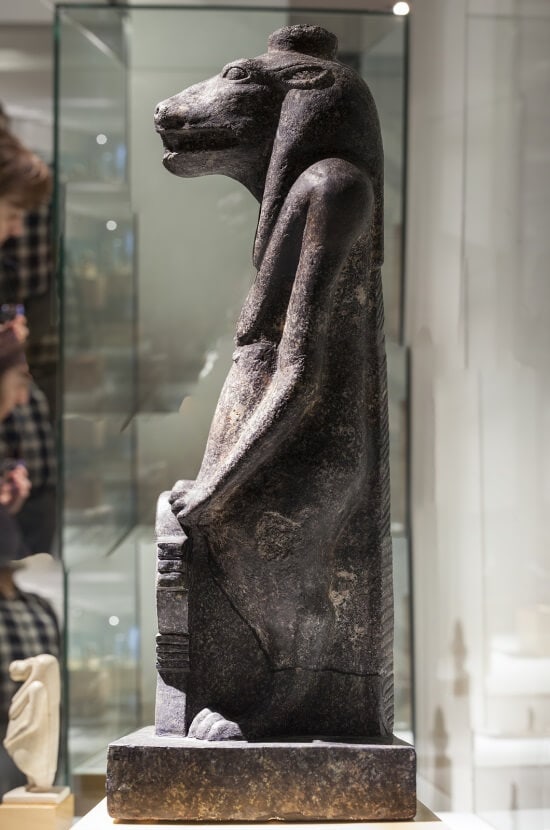
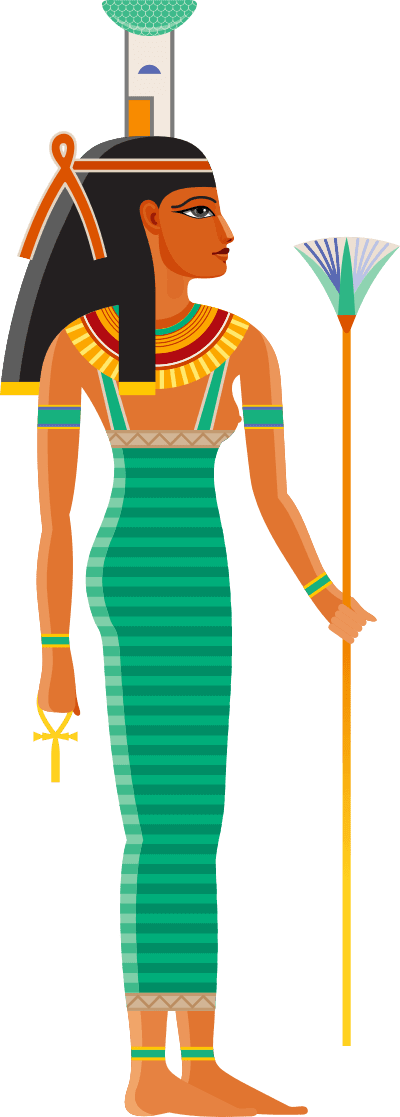
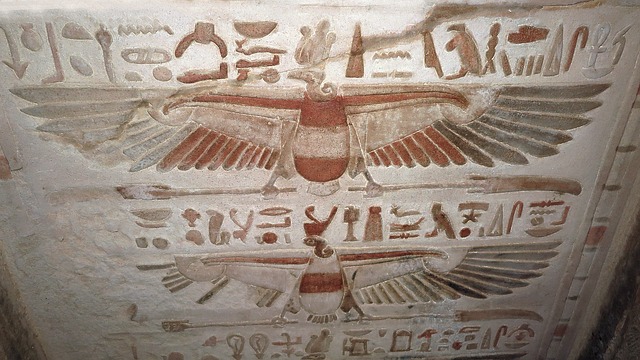
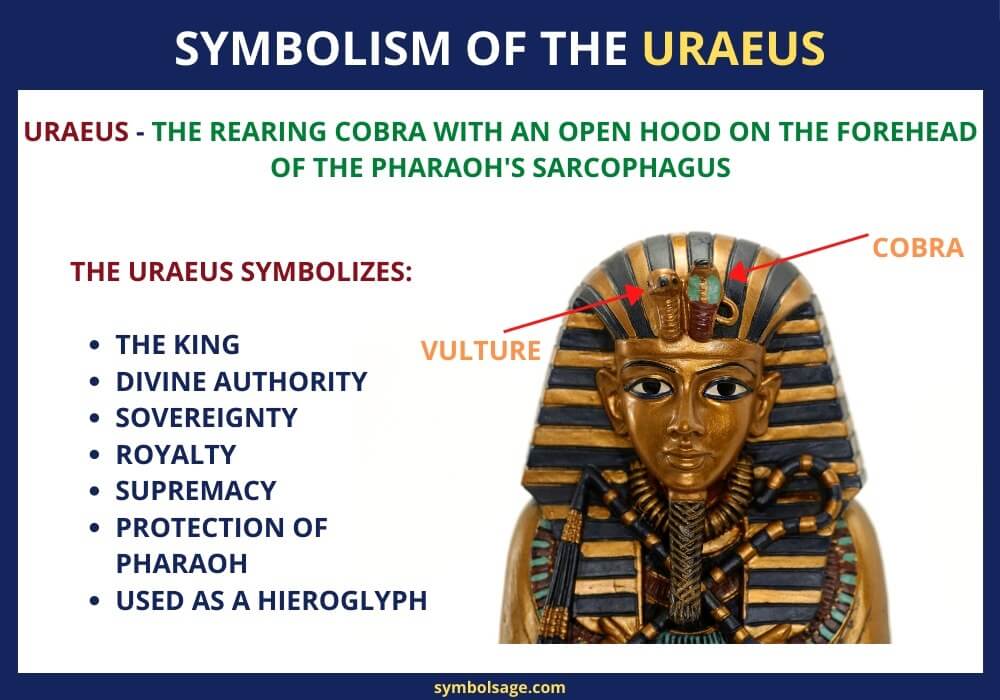
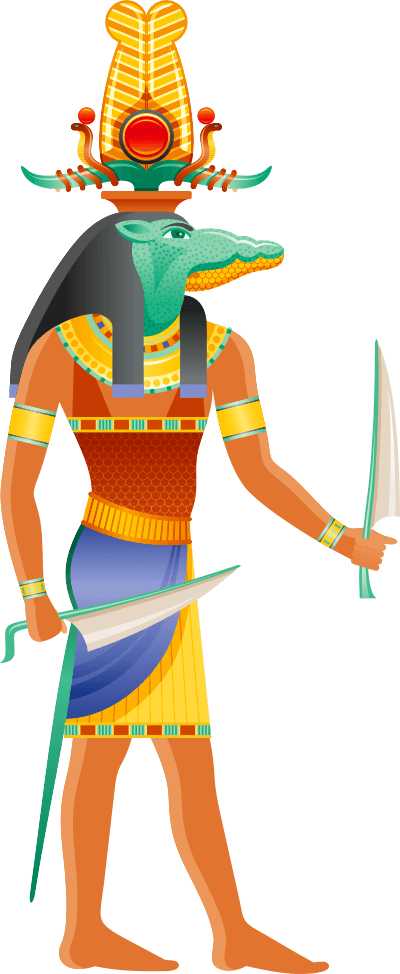
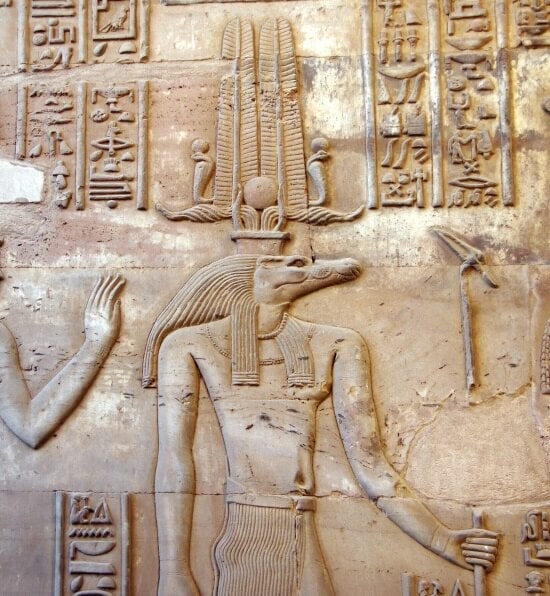
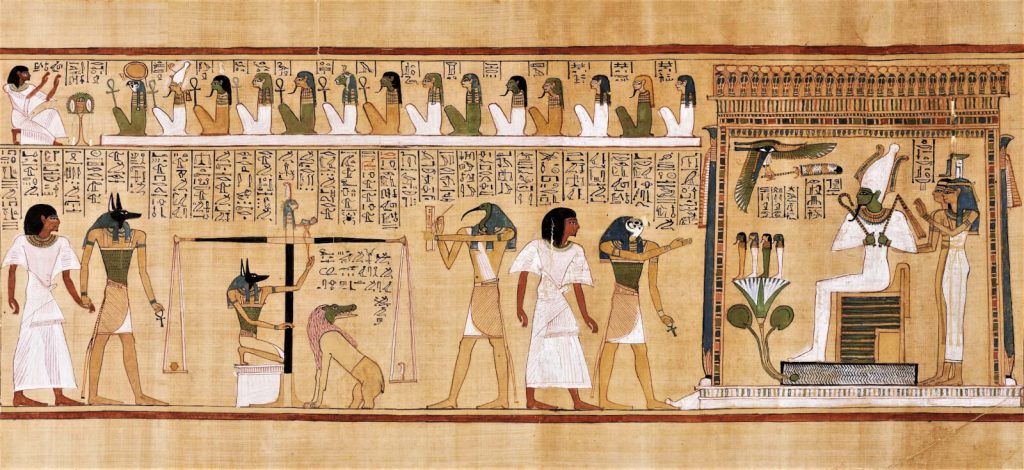



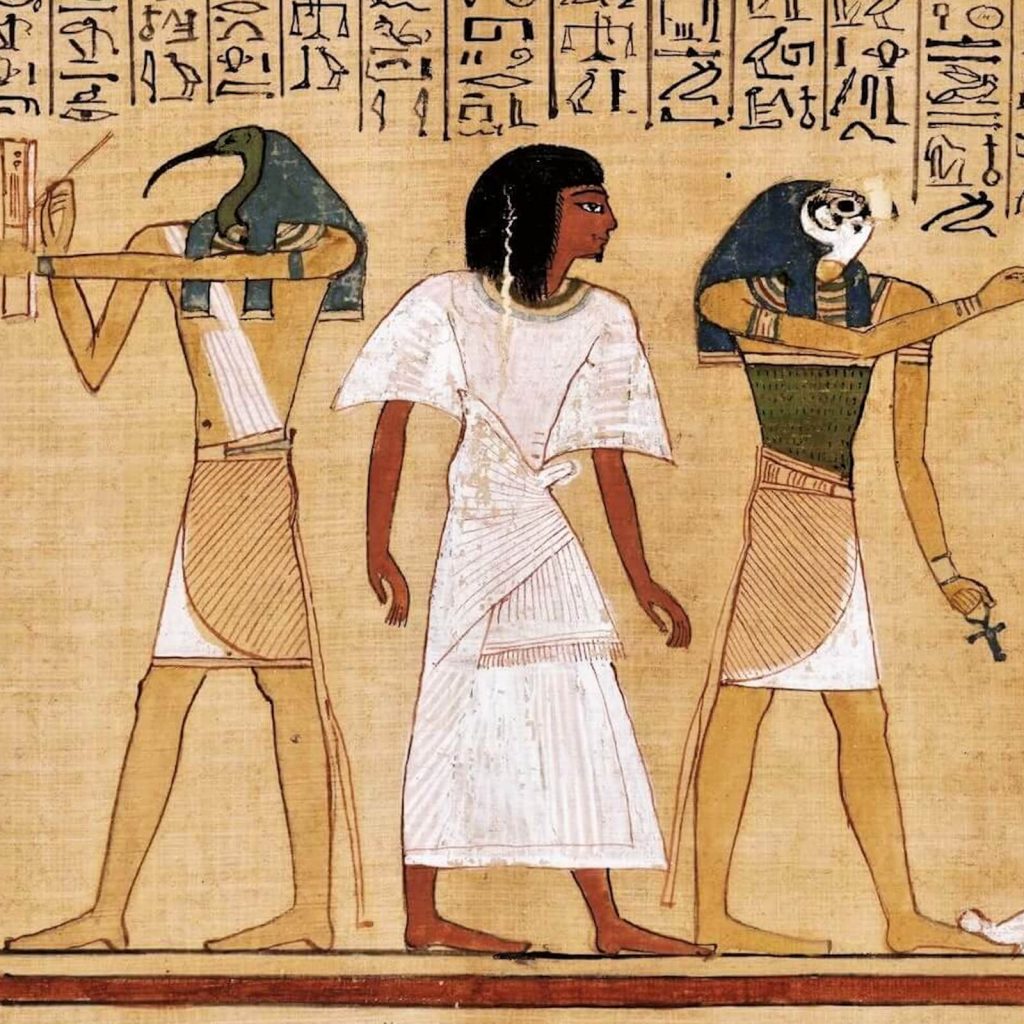
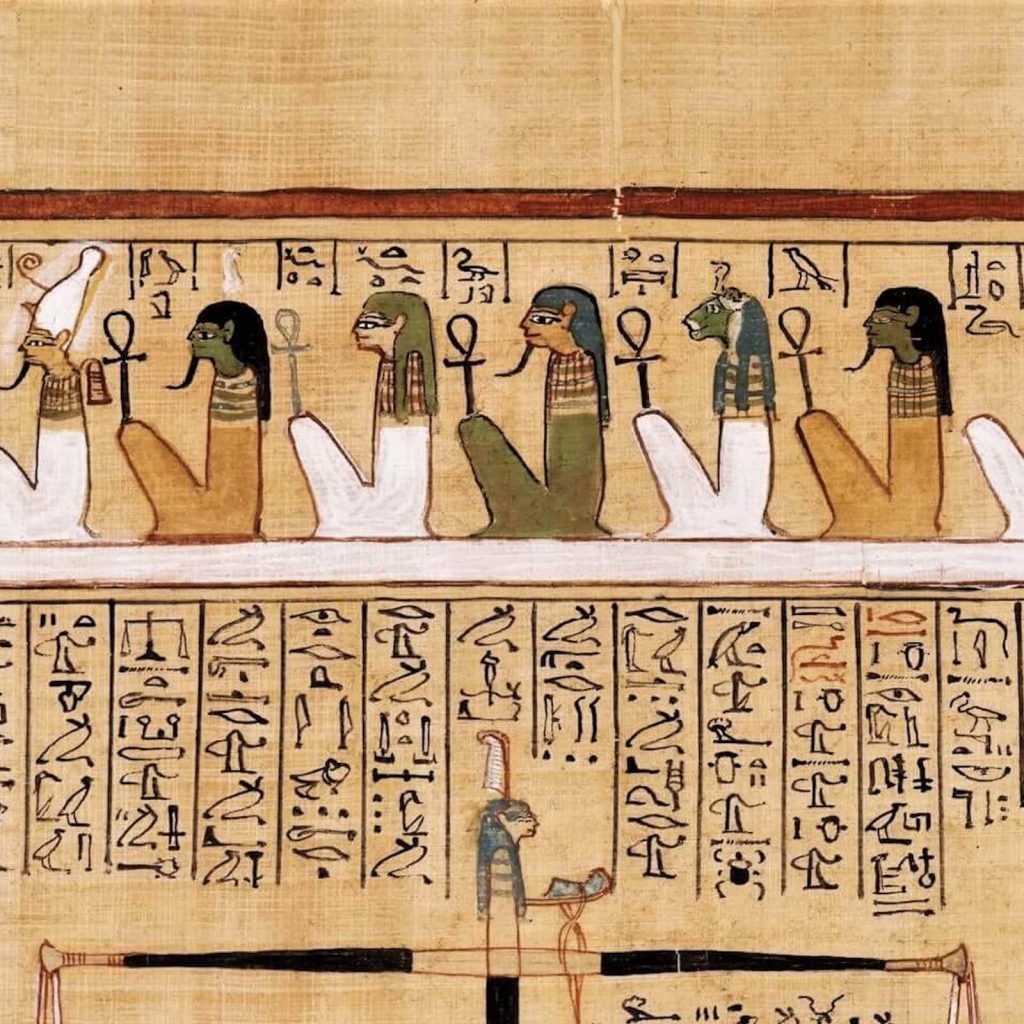
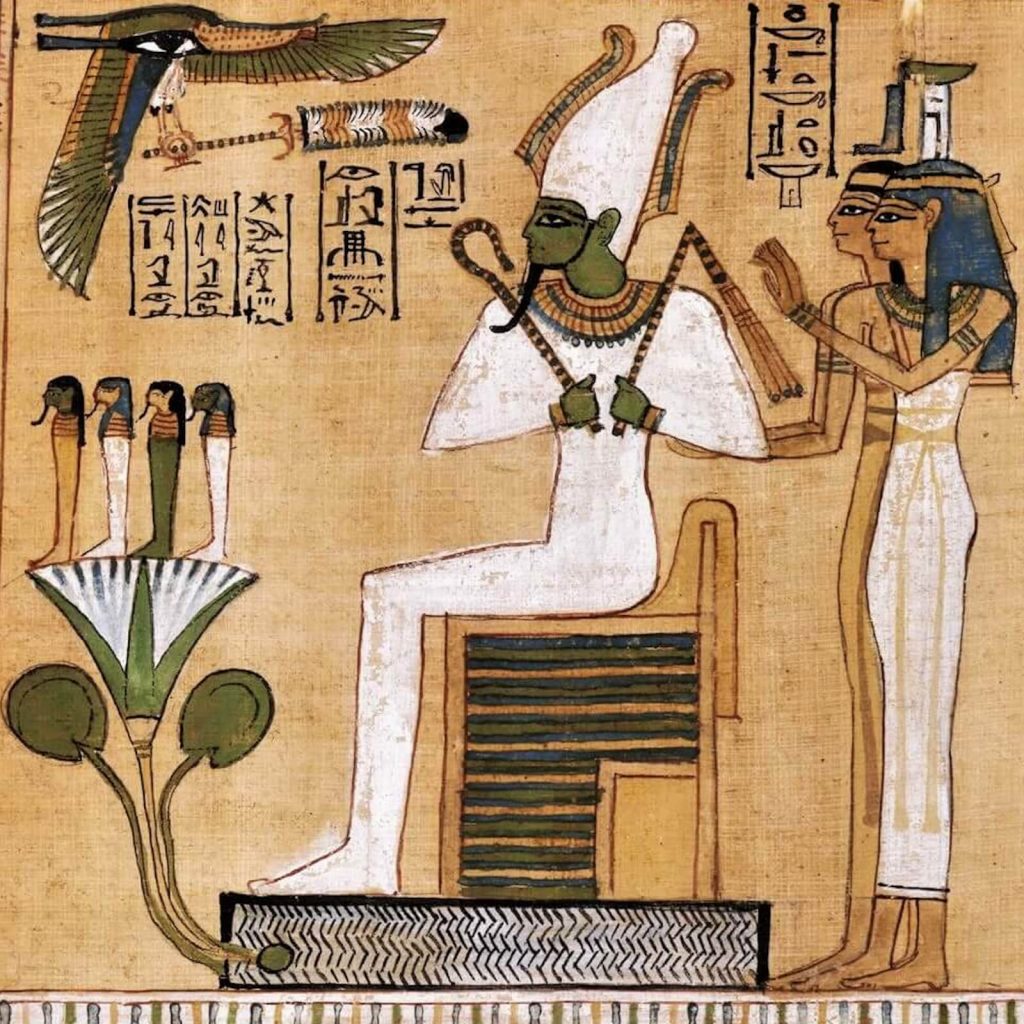



 Traditionally, the decks like the Marseilles Tarot decks have placed the Justice card as the 8th card, and the Strength card as the 11th card in the Major Arcana. The images remained pretty much the same as as they are today – just the numbering was different.
Traditionally, the decks like the Marseilles Tarot decks have placed the Justice card as the 8th card, and the Strength card as the 11th card in the Major Arcana. The images remained pretty much the same as as they are today – just the numbering was different.
 In the RWS deck, however, A.E. Waite placed Strength as the 8th Trump and Justice as the 11th Trump. Naturally he was quite criticized for changing the traditional placement of these cards, but then, this placement makes more sense on an Astrological perspective.
In the RWS deck, however, A.E. Waite placed Strength as the 8th Trump and Justice as the 11th Trump. Naturally he was quite criticized for changing the traditional placement of these cards, but then, this placement makes more sense on an Astrological perspective.
